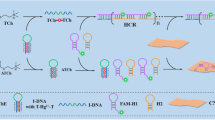Abstract
We present a versatile and facile route for highly sensitive detection of analytes through coupling the enlargement of gold nanoparticles (Au NPs) with fluorescence decrease. The fluorescence intensity of dye molecules (e.g., fluorescein or rhodamine B) significantly decreased with the increasing concentration of reducing agents, such as hydrogen peroxide and hydroquinone. The sensitivity for the detection of reducing agents was much higher than other detection methods based on the absorbance measurement of enlarged gold nanoparticles or quantum dot-enzyme hybridization. We could successfully detect acetylthiocholine with the detection limit of several nM orders, using an enzymatic reaction by acetylcholinesterase, a key route for the detection of toxic organophosphate compounds. The fluorescence decreasing approach described in this work requires only a simple addition of fluorescence dye to the reaction solution without any chemical modification. The strategy of fluorescence decrease coupled with nanoparticle growth will be applied on the fluorescent substrate to develop detection templates for highly sensitive optical biosensor.
Similar content being viewed by others
References
Zayats, M.; Baron, R.; Popov, I.; Willner, I. Nano Lett. 2005, 5, 21–25.
Jagetia, G. C.; Menon, K. S. L.; Jain, V. Toxicol. Lett. 2001, 121, 15–20.
Dutta, K.; Bhattacharyay, D.; Mukherjee, A.; Setford, S. J.; Turner, A. P. F.; Sarkar, P. Ecotox. Environ. Safe. 2008, 69, 556–561.
Bültzingslöwen, C.; McEvoy, A. K.; McDonagh, C.; MacCraith, B. D. Anal. Chim. Acta 2003, 480, 275–283.
Pickup, J. C.; Hussain, F.; Evans, N. D.; Rolinski, O. J.; Birch, D. J. S. Biosens. Bioelectron. 2005, 20, 2555–2565.
Griffin, J.; Singh, A. K.; Senapati, D.; Rhodes, P.; Mitchell, K.; Robinson, B.; Yu, E.; Ray, P. C. Chem. Eur. J. 2009, 15, 342–351.
Lee, S.; Cha, E-J.; Park, K.; Lee, S-Y.; Hong, J-K.; Sun, I-C; Kim, S. Y.; Choi, K.; Kwon, I. C.; Kim, K. et al. Angew. Chem. Int. Ed. 2008, 47, 2804–2807.
Maxwell, D. J.; Taylor, J. R.; Nie, S. J. Am. Chem. Soc. 2002, 124, 9606–9612.
Zhu, L.; Lee, C. S.; DeVoe. D. L. Lab Chip 2006, 6, 115–120.
Yuan, J.; Guo, W.; Wang, E. Anal. Chem. 2008, 80, 1141–1145.
Author information
Authors and Affiliations
Rights and permissions
About this article
Cite this article
Lim, S.Y., Kim, J.H., Lee, J.S. et al. Gold Nanoparticle Enlargement Coupled with Fluorescence Decrease for Highly Sensitive Detection of Analytes. MRS Online Proceedings Library 1301, 235–240 (2011). https://doi.org/10.1557/opl.2011.73
Published:
Issue Date:
DOI: https://doi.org/10.1557/opl.2011.73




